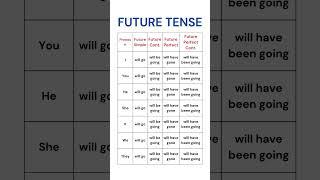
Future Tenses: Simple, Continuous, Perfect & Perfect Continuous | Pronoun Table Explained #tenses
In this video, you’ll master the four essential future tenses in English: Future Simple, Future Continuous, Future Perfect, and Future Perfect Continuous, with a detailed pronoun table. Understanding how these tenses work is key to speaking and writing in English fluently. This video covers how each pronoun—I, you, he, she, it, we, they—changes with these tenses using the verb "go" as an example.
Future Simple: Used for actions that will happen in the future. Example: "I will go to the store."
Future Continuous: Describes actions that will be ongoing at a specific time in the future. Example: "I will be going to the store."
Future Perfect: Refers to actions that will have been completed by a certain time in the future. Example: "I will have gone to the store."
Future Perfect Continuous: Highlights actions that will have been ongoing for a period of time before a future point. Example: "I will have been going to the store."
With easy examples and a structured table, this video will help you understand how to use future tenses in real-life conversations, exams, and writing. Whether you're a beginner or an advanced English learner, this guide will enhance your grammar and fluency.
Don't forget to subscribe for more helpful English grammar lessons! Be sure to like, share, and comment if you found this video useful. Thanks for watching!
#FutureTenses #EnglishGrammar #FutureSimple #FutureContinuous #FuturePerfect #FuturePerfectContinuous #LearnEnglish #EnglishTenses #EnglishLearning #GrammarTips #EnglishBasics #VerbTenses #StudyEnglish #EnglishForBeginners #GrammarHelp #ImproveEnglish #StudyTenses #FutureTenseExplanation #MasterEnglish #TenseTable #GrammarLesson #VerbConjugation #LanguageLearning #ESL #EnglishSpeaking #DailyEnglish #StudyEnglishOnline #TenseChart #GrammarRules #MasterTenses #ConjugationTable #FluentEnglish #EnglishVideo #GrammarSkills #EnglishPractice #StudyTensesOnline #EnglishTutorial #EnglishEducation #TenseGuide #grammar #learnenglish
Future Simple: Used for actions that will happen in the future. Example: "I will go to the store."
Future Continuous: Describes actions that will be ongoing at a specific time in the future. Example: "I will be going to the store."
Future Perfect: Refers to actions that will have been completed by a certain time in the future. Example: "I will have gone to the store."
Future Perfect Continuous: Highlights actions that will have been ongoing for a period of time before a future point. Example: "I will have been going to the store."
With easy examples and a structured table, this video will help you understand how to use future tenses in real-life conversations, exams, and writing. Whether you're a beginner or an advanced English learner, this guide will enhance your grammar and fluency.
Don't forget to subscribe for more helpful English grammar lessons! Be sure to like, share, and comment if you found this video useful. Thanks for watching!
#FutureTenses #EnglishGrammar #FutureSimple #FutureContinuous #FuturePerfect #FuturePerfectContinuous #LearnEnglish #EnglishTenses #EnglishLearning #GrammarTips #EnglishBasics #VerbTenses #StudyEnglish #EnglishForBeginners #GrammarHelp #ImproveEnglish #StudyTenses #FutureTenseExplanation #MasterEnglish #TenseTable #GrammarLesson #VerbConjugation #LanguageLearning #ESL #EnglishSpeaking #DailyEnglish #StudyEnglishOnline #TenseChart #GrammarRules #MasterTenses #ConjugationTable #FluentEnglish #EnglishVideo #GrammarSkills #EnglishPractice #StudyTensesOnline #EnglishTutorial #EnglishEducation #TenseGuide #grammar #learnenglish
Комментарии:
จุดพลุให้โลกจดจำว่าที่นี่คือเมืองไทย!! คนไทยยินดีต้อนรับคนทั้งโลกด้วยใจจริง Vijit Chao Phraya 2024
บ่าวผู้ไทขาเลาะ BaoPhutai on tour
Under-rated Genius of Package Design
Capt_Kraboo
تغريد جميل نادر يعود الى 1985 هدية لكل عشاق طائر الحسون
canari _chardonneret
가족한텐 얼마든지 써도 된다길래...
푸르른소라TV・プルルンそらTV


























